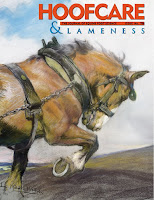The Calgary Stampede put together this little video about the farrier competition.
"Beane" there, done that--Two years in a row!
Steven Beane of England, shown early in this video, was named the 2010 World Champion Blacksmith at the Calgary Stampede today. That makes it two in a row for the Yorkshire farrier, who was also champion in 2009 and is currently reserve European champion for 2010.
According to the Calgary Stampede, Beane was virtually unbeatable when it counted Sunday, dominating the semifinal and final rounds under the Big Top to win his second consecutive World Championship Blacksmiths’ Competition title at the Calgary Stampede.
Beane, who hails from Northallerton, North Yorkshire, is the first backto-back WCBC champion since Billy Crothers of Wales won the second and third of his five Stampede crowns back in 1995 and 1996.
“It’s unbelievably hard to do that. Really, really hard,” said Beane, 31. “You’ve got so many good guys competing here . . . you’ve got to be on the top of your game, and I’m lucky I was on top of my game today.
“I’ve had a bad year up until now, to be honest,” added Beane, who said he competes at between 15 and 20 farrier competitions during a year. “I went to the European championships, where I’d won two years in a row, and I was second there. That was kind of hard to take. But I must admit that for the last couple of months, I’ve been focused on coming back here.”
Beane finished with 147 points to Engler’s 115. As for the other finalists, Scotland’s Derek Gardner was
third with 115 (Engler won a tiebreaker on the fit of a horse’s shoe); fellow Scot David Varini was fourth with 94, and Texan Gene Lieser ended up fifth with 87.
Beane wins a cheque for $10,000, as well as a gold-and-silver Stampede championship buckle, a limited edition bronze trophy, and a champion’s jacket. More than $50,000 in cash and prizes were handed out to WCBC competitors this weekend.
“It was pretty rough going for me today. Nothing was clicking,” said Engler. “Beane is always on the money, and he’s hard to beat. But I’m pretty happy with (second place). It can’t be too bad, since there’s only one guy better than me.”
Congratulations to all the farriers who made the trip to Calgary and represented their countries.
Information and quotes provided by the Calgary Stampede were used in this report. Photo and video courtesy of the Calgary Stampede.
Fran Jurga's Hoof Blog at Hoofcare.com
© Fran Jurga and Hoofcare Publishing
Fran Jurga's Hoof Blog is a between-issues news service for subscribers to Hoofcare and Lameness Journal. Please, no use without permission. You only need to ask. This blog may be read online at the blog page, checked via RSS feed, or received via a digest-type email (requires signup in box at top right of blog page). To subscribe to Hoofcare and Lameness (the journal), please visit the main site, www.hoofcare.com, where many educational products and media related to equine lameness and hoof science can be found. Questions or problems with this blog? Send email to blog@hoofcare.com.








